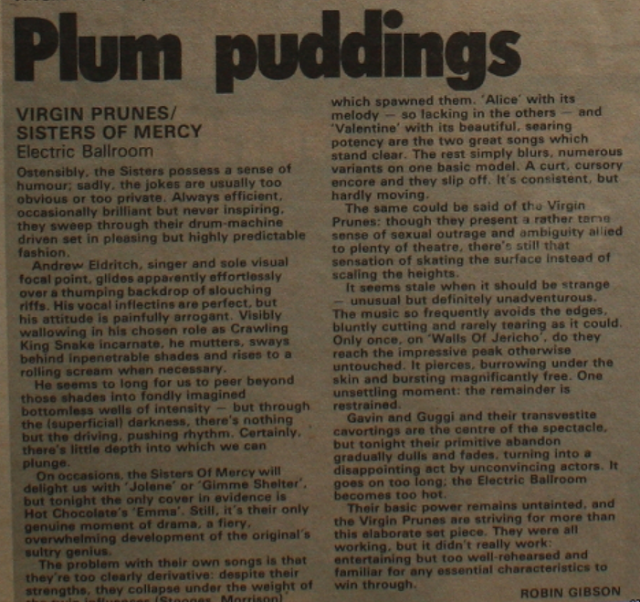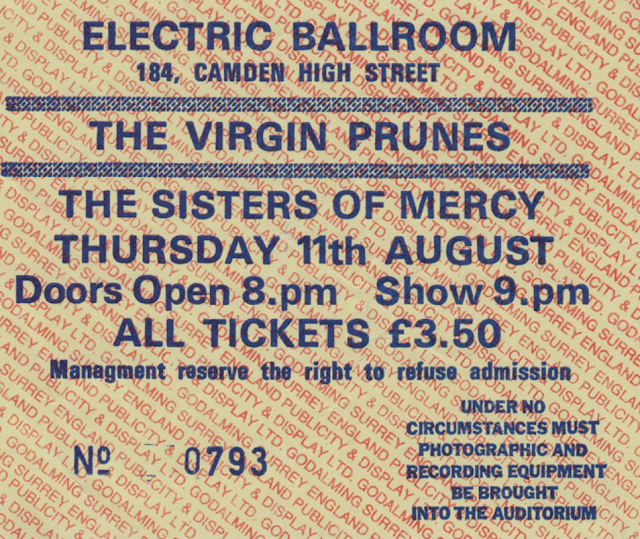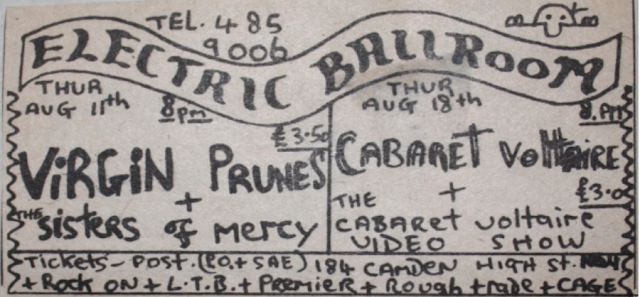Since this blog started well over a decade ago, two books
have been published about The Sisters of Mercy, the first being Trevor Ristow’s
Waiting For Another War (reviewed here and available here), which is
notable for its extensive research and revelations about the band’s various US
trips in the early/mid-1980’s.
As we have already chronicled, the Sisters received better press coverage Stateside than they did in the UK, which wouldn't have been difficult given the bizarre non-appearance of the band even in UK alternative publications like Punk Lives and Jamming. Well-respected music journalists in venerable generalist regional titles like The Washington Post, LA Times and the Boston Globe all featured the band well before their name would grace any of the English national daily papers, for example, and gave the band a more fair appraisal than the contemporary specialist broadsheets in the UK could manage.
Freed from the straitjacket of heavily gatekept genres and with a more ready appreciation of what the “spirit of Altamont” actually entailed, US musical aficionados and journalists seemed to be able to “get” The Sisters straight away, whether or not the actual songs were their “cup of tea” (or whatever the American equivalent is) and were quick to appreciate and in some cases embrace the band’s musical, lyrical and stylistic aesthetic, as well as the quintessentially British persona projected by Andrew Eldritch, who endeared himself to Americans in the same way as artists as diverse as Quentin Crisp and Hugh Grant (pre-arrest!) also managed to achieve.
One of the few national musical publications in the USA to enthuse
about any act which had followed in the wake of punk, Trouser Press had
begun life in 1974 as a fanzine (with a much longer name) to showcase UK-based
talent in the States, but by the late 70’s it was a more professional magazine with
a circulation of sixty thousand per issue and a less Anglocentric slant. Along
the way it had acquired a well-deserved impressive critical reputation, so much
so that it was able to branch out into its seminal Record Guides in the
1980’s.
One of its most respected writers was Jim Green, who penned
the monthly’s singles review column Green Circles, which was avidly read
by college radio DJ’s and gig promoters across the States. As music blogger
Post-Punk Monk recalls: “Jim Green would weigh in on the calibre of non-LP
B-sides for import single cognoscenti like myself. At the very least, you got
to know what tracks each single held; invaluable for making a purchasing
decision! If the records were 6-8 weeks old by the time they went to press,
remember: it was a slower time. It might take that long for anything I wanted
to filter down to Central Florida anyway.”
Whilst Rolling Stone (much like the NME in the
UK) had writers such as Lester Bangs and Greil Marcus who seemed to believe
that they were the star of the show and the artists mere players, Trouser Press’ own team of writers
under founder editors Ira Robbins, Dave Schulps and Karen Rose were happy for
their enthusiasm for the music to take the limelight, and Jim Green was very
much of that ilk (so much so that a quick Google of his name will reveal
precious little about his own life).
Responding to a request on the Trouser Press online
forum twenty years ago for more information about his own involvement in the
music scene, Green revealed “Here’s more than you possibly want to know. I used
to special order singles for my Trouser Press column from a record store
on the Upper East Side, near Dave Schulps' apartment. Dave introduced me to the
guy who worked there, who was really helpful, just a great guy. The latter told
me a friend of his from back home had a band that was putting out its own
single, and could he have them send it to me. I said ‘Fine’, and got the first
few singles by this group, and exchanged letters with their singer, then
calling himself Crocus Behemoth. Yup, the group was Pere Ubu! The record store
guy himself said he had a band, and would Dave and i come see their first ever
gig at Max's Kansas City. We said ‘Of course!’. His name was Lux Interior, and
that [band] was The Cramps” (Presumably the store in question was Musical Maze).
Unsurprising, therefore, that Green would eventually stumble
across and like The Sisters of Mercy (with the band being of course huge fans of both The Cramps and Pere Ubu), thanks presumably to their constant presence in
the upper echelons of the UK’s Alternative/Independent chart listings, penning his first review of band’s recorded
output in the September 1983 edition of Trouser Press (which featured
the then-extravagantly-coiffured A Flock of Seagulls by Ebet Roberts on the cover). The
selection of Merciful Release records Green reviewed is notable not only for
the inclusion of Body Electric/Adrenochrome, which was increasingly hard
to find in the UK let alone in the US at that time, but also for that of the
Salvation single Girlsoul, but attributed here to the band’s previous
name Black Paris, under which moniker they had recorded the songs in the
infamous session at Ken Giles’ Bridlington studios and a name which they kept until
shortly before the EP was issued, as was confirmed in Ristow's book. These facts might lead one to believe that Green’s
source for the records he was reviewing in this instance was probably Eldritch
himself, given that the Salvation single was not finally released in the UK
until October of that year (and, obviously, under the band’s new name).
Interestingly, Green was clearly not yet afforded access to Temple of Love,
which would ultimately be released before the Salvation debut EP and which was
being shared with UK journalists at this time.
In the review itself, Green gives a measured if personal view of the band’s development from the “first single” (with Eldritch airbrushing Damage Done from collective memory at that time) to the more recent The Reptile House EP, with complaints about the latter’s “sub-par” production but praise for the increased sophistication of the songs’ structures over time being typical of the more discerning critics of that era, and an assessment that many would recognise as realistic and fair to this day.
Just three months later, Green featured The Sisters’ latest
release (the Temple of Love 12”) in his Green Circles column, in
a rave review which praised all three tracks, with appreciation for the
“thought and cleverness” behind the title track, the “similarly effective” Heartland
and turning Gimme Shelter into an “apocalyptic hymn”. Eldritch would
surely have particularly appreciated the closing remark: “Neat stuff, fellas”, effectively
a warm welcome into the pantheon of American rock’n’roll history, an accolade
he had clearly relished.
Despite these two reviews being the only references to the band in the full online archive of Trouser Press (see below for details - it's well worth a browse!), The Sisters may have gone on to feature regularly in the magazine, but for the fact that Ira Robbins and co suddenly decided to pull the plug on the publication after its tenth anniversary issue in April of 1984, on the eve of The Sisters of Mercy’s first major label release. Subscribers were transferred over to Rolling Stone’s offshoot Record, which was unlikely to feature any bands from the English positive punk scene, and which also disappeared from the racks shortly afterwards.
Robbins explained
the decision to close TP in a recent (2024) interview with Rock and
Roll Globe to mark the fiftieth anniversary of the magazine’s original
launch: “Once the New Wave moved on, we followed that path into post-punk and
the New Romantics and the MTV era, which proved to be our undoing. We were not
as keen on Adam [Ant] and Duran Duran and Culture Club and Big Country as we
had been on The Clash and The Sex Pistols and The Damned and The Stranglers and
Siouxsie and stuff. So, our coverage became half-hearted.
Three-quarter-hearted, let’s be fair. And we attracted an audience because MTV
had built an audience of young kids who were attracted by the colourful bands
and the pop songs. And that audience found us but didn’t find our somewhat more
sophisticated, cynical, sarcastic view of their music as appealing as what MTV
was selling.”
If Robbins was at best luke-warm about the commercially
successful post-punk/New Romantic acts, he was openly hostile to bands of the
positive-punk sub-genre. Apart from The Sisters, much of what became known as
the goth scene was openly derided in the review pages of the latter issues of
Trouser Press, as this typical four album mauling by Robbins himself will
testify…
Had time caught up with a generation of music journalists
who had always prided themselves on being ahead of the curve? The exasperation
in Robbins’ tone in that review would tend to suggest that this was the case, and
comments from the afore-mentioned interview of earlier this year seem to
confirm this version of events; “We were getting older, and we were running out
of money, and we just didn’t care as much about what we were doing. And it just
seemed like a good time to stop.” In any case, the untimely demise of the one
national music outlet likely to give a promising US career a significant boost
prevented The Sisters from making the big leap forward that would eventually
come a few years later, but in their own small way, the influential Jim Green’s positive reviews
of the early releases helped to establish TSOM as serious players on the
alternative scene across the pond.
This post is dedicated to Jim Green, Ira Robbins and the team at Trouser Press, the band's chief unofficial US biographer, and my fellow TSOM internet sleuth Ade Matthews. For more about the early years of The Sisters of Mercy, check out the unofficial 1980-1985 TSOM Facebook page. The band still tours to this day and information can be found on the official website. The full archive of Trouser Press is available here with a very handy artist pre-search here.










.jpg)
.jpg)
.jpg)














